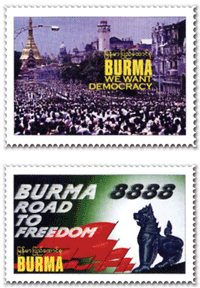Stamping Out History
(Page 2 of 2)
 |
Burmese stamps of the future? |
After the 1988 uprising, the “Burmese Way to Socialism” was abandoned, but military rule prevailed. Min Sun Min does not include any post-1988 stamps in his book, “because it was a turning point in Burmese history. That was the year when the military illegitimately assumed (direct) power.”
The last set of stamps depicted in the book—designed by Min Sun Min and, therefore, yet to be issued—show demonstrators thronging the streets of Rangoon and a Buddhist monk exhorting his audience at a rally in the capital in 1988.
Thus, the book ends on a very positive note: Min Sun Min has faith in a democratic future for Burma. The images of the cataclysmic events of 1988 will not be forgotten, he writes, and, “They deserve to be recorded and issued as stamps, one day, when Burma is free.”
Bertil Lintner is a correspondent who specializes in Burma and Asian issues. His latest book is Aung San Suu Kyi and Burma’s Struggle for Democracy (in Korean)
« previous 1 | 2 |
